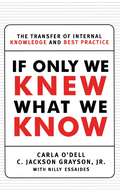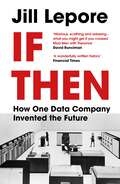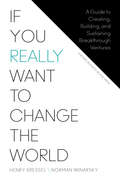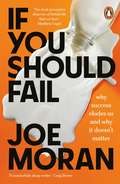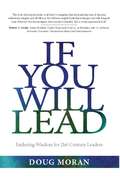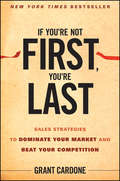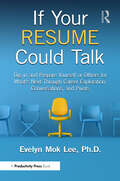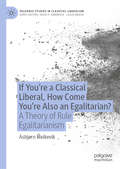- Table View
- List View
If It Wasn't For the People...This Job Would Be Fun: Coaching for Buy-In and Results
by C. B. MotsettIf It Wasn't For the People...This Job Would Be Fun provides executives, managers, and supervisors with the techniques needed to ensure that employees willingly and consistently perform to ever higher levels of expectation. Not only does following this process give readers the results, it also effectively transfers the responsibility for an employee's actions or inaction's where it belongs-on that person's shoulders. Readers will learn that leading doesn't mean doing the other person's job for them or watching over their shoulder. Leading means getting the best results by not telling experts how to do jobs they already understand, but by making sure they know what is expected of them and then allowing them to perform.
If It's Lonely at the Top, You're Not Doing Something Right
by John MaxwellSmart leaders learn from their own mistakes. Smarter ones learn from others' mistakes--and successes. John C. Maxwell wants to help you become the smartest leader you can be by sharing Chapter 1, If It's Lonely At The Top, You're Not Doing Something Right, of Leadership Gold with you. After nearly forty years of leading, Maxwell has mined the gold so you don't have to. Each chapter contains detailed application exercises and a "Mentoring Moment" for leaders who desire to mentor others using the book. Gaining leadership insight is a lot like mining for gold. You don't set out to look for the dirt. You look for the nuggets. You'll find them here.
If It's Raining In Brazil, Buy Starbucks: The Investor's Guide To Profiting From Market-Moving Events
by Peter NavarroFrom mid-March to mid-May of 2000 the NASDAQ suffered a 40 percent drop from its all-time high of 5132. This tumble was caused by a combination of forces: the failure of Microsoft and the Justice department to resolve their anti-trust dispute, an unexpected jump in the CPI, and Federal Reserve Chairman Alan Greenspan's increase in interest rates. The drop eliminated millions of dollars of wealth and left thousands of investors wiped out. The lesson was clear: any trader or investor who ignores the power macroeconomic forces have over the world's financial markets will lose more than they should. This text introduces the trader and investor to the power of large, global economic forces and explains in detail how these forces affect the market. It provides a big picture overview of the global fundamentals that move the market as well as individual stocks, clearly showing the links between major economic events and stock market movement. The author looks at how and why these sectors respond differently to economic forces. The book applies macroeconomic theory to the practical world of stock trading, using real-life examples to illustrate key points and simulation and case studies to show profitable trading based on macroeconomic news. The author focuses on specific macroeconomic forces, which economic indicators are important to follow, and which sectors of the economy react to different indicators, providing traders and investors with clear trading signals. Topics include: trading in inflationary or recessionary environments, how fiscal and monetary policy affect the market, and technological change and how to take advantage of it.
If Only We Knew What We Know
by C. Jackson Grayson Carla O'DellWhile companies search the world over to benchmark best practices, vast treasure troves of knowledge and know-how remain hidden right under their noses: in the minds of their own employees, in the often unique structure of their operations, and in the written history of their organizations. Now, acclaimed productivity and quality experts Carla O'Dell and Jack Grayson explain for the first time how applying the ideas of Knowledge Management can help employers identify their own internal best practices and share this intellectual capital throughout their organizations. Knowledge Management (KM) is a conscious strategy of getting the right information to the right people at the right time so they can take action and create value. Basing KM on three major studies of best practices at one hundred companies, the authors demonstrate how managers can utilize a visual process model to actually transfer best practices from one business unit of the organization to another. Rich with case studies, concrete examples, and revealing anecdotes from companies including Texas Instruments, Amoco, Buckman, Chevron, Sequent Computer, the World Bank, and USAA, this valuable guide reveals how knowledge treasure chests can be unlocked to reduce product development cycle time, implement more cost-efficient operations, or create a loyal customer base. Finally, O'Dell and Grayson present three "value propositions" built around customers, products, and operations that could result in staggering payoffs as they did at the companies cited above. No amount of knowledge or insight can keep a company ahead if it is not properly distributed where it's needed. Entirely accessible and immensely readable, If Only We Knew What We Know is a much-needed companion for business leaders everywhere.
If Only We Knew What We Know: The Transfer of Internal Knowledge and Best Practi
by C. Jackson Grayson Carla O'DellWhile companies search the world over to benchmark best practices, vast treasure troves of knowledge and know-how remain hidden right under their noses: in the minds of their own employees, in the often unique structure of their operations, and in the written history of their organizations. Now, acclaimed productivity and quality experts Carla O'Dell and Jack Grayson explain for the first time how applying the ideas of Knowledge Management can help employers identify their own internal best practices and share this intellectual capital throughout their organizations.Knowledge Management (KM) is a conscious strategy of getting the right information to the right people at the right time so they can take action and create value. Basing KM on three major studies of best practices at one hundred companies, the authors demonstrate how managers can utilize a visual process model to actually transfer best practices from one business unit of the organization to another. Rich with case studies, concrete examples, and revealing anecdotes from companies including Texas Instruments, Amoco, Buckman, Chevron, Sequent Computer, the World Bank, and USAA, this valuable guide reveals how knowledge treasure chests can be unlocked to reduce product development cycle time, implement more cost-efficient operations, or create a loyal customer base. Finally, O'Dell and Grayson present three "value propositions" built around customers, products, and operations that could result in staggering payoffs as they did at the companies cited above.No amount of knowledge or insight can keep a company ahead if it is not properly distributed where it's needed. Entirely accessible and immensely readable, If Only We Knew What We Know is a much-needed companion for business leaders everywhere.
If Scotland Goes
by VariousThe FT's latest ebook is a guide to what would happen if Scotland were to vote for independence in a referendum in September 2014. While the outcome is far from certain, a yes vote would have a profound effect not only on the 5.3m people of Scotland, but also on the economic future and fundamental character of the UK. We introduce Alex Salmond, the Scottish first minister and driving force behind the independence campaign. We examine the difficult economic issues, led by an independent Scotland's choice of currency, and the potential benefits independence would bring for example in a separate immigration policy. We include observations from an expatriate Scot that give a flavour of the personal and social backdrop to the constitutional choice. This collection of articles - a mixture of dispassionate reporting and trenchant comment and analysis - first published by the Financial Times between November 2013 and February 2014 is a must for anybody seeking a quick introduction to one of the biggest political events of the year.
If Then: How One Data Company Invented the Future
by Jill LeporeRadio 4's Book of the WeekA Financial Times Book of the YearShortlisted for the 2020 Financial Times / McKinsey Business Book of the YearLonglisted for the National Book Award 'The story of the original data science hucksters of the 1960s is hilarious, scathing and sobering - what you might get if you crossed Mad Men with Theranos' David RuncimanThe Simulmatics Corporation, founded in 1959, mined data, targeted voters, accelerated news, manipulated consumers, destabilized politics, and disordered knowledge--decades before Facebook, Google, Amazon, and Cambridge Analytica. Silicon Valley likes to imagine it has no past but the scientists of Simulmatics are the long-dead grandfathers of Mark Zuckerberg and Elon Musk. Borrowing from psychological warfare, they used computers to predict and direct human behavior, deploying their "People Machine" from New York, Cambridge, and Saigon for clients that included John Kennedy's presidential campaign, the New York Times, Young & Rubicam, and, during the Vietnam War, the Department of Defence. In If Then, distinguished Harvard historian and New Yorker staff writer, Jill Lepore, unearths from the archives the almost unbelievable story of this long-vanished corporation, and of the women hidden behind it. In the 1950s and 1960s, Lepore argues, Simulmatics invented the future by building the machine in which the world now finds itself trapped and tormented, algorithm by algorithm.'A person can't help but feel inspired by the riveting intelligence and joyful curiosity of Jill Lepore. Knowing that there is a mind like hers in the world is a hope-inducing thing' George Saunders, Man Booker Prize-winning author of Lincoln in the Bardo'An authoritative account of the origins of data science, a compelling political narrative of America in the Sixties, a poignant collective biography of a generation of flawed men' David Kynaston'If Then is simultaneously gripping and absolutely terrifying' Amanda Foreman
If Then: How One Data Company Invented the Future
by Jill LeporeRadio 4's Book of the WeekA Financial Times Book of the YearShortlisted for the 2020 Financial Times / McKinsey Business Book of the YearLonglisted for the National Book Award 'The story of the original data science hucksters of the 1960s is hilarious, scathing and sobering - what you might get if you crossed Mad Men with Theranos' David RuncimanThe Simulmatics Corporation, founded in 1959, mined data, targeted voters, accelerated news, manipulated consumers, destabilized politics, and disordered knowledge--decades before Facebook, Google, Amazon, and Cambridge Analytica. Silicon Valley likes to imagine it has no past but the scientists of Simulmatics are the long-dead grandfathers of Mark Zuckerberg and Elon Musk. Borrowing from psychological warfare, they used computers to predict and direct human behavior, deploying their "People Machine" from New York, Cambridge, and Saigon for clients that included John Kennedy's presidential campaign, the New York Times, Young & Rubicam, and, during the Vietnam War, the Department of Defence. In If Then, distinguished Harvard historian and New Yorker staff writer, Jill Lepore, unearths from the archives the almost unbelievable story of this long-vanished corporation, and of the women hidden behind it. In the 1950s and 1960s, Lepore argues, Simulmatics invented the future by building the machine in which the world now finds itself trapped and tormented, algorithm by algorithm.'A person can't help but feel inspired by the riveting intelligence and joyful curiosity of Jill Lepore. Knowing that there is a mind like hers in the world is a hope-inducing thing' George Saunders, Man Booker Prize-winning author of Lincoln in the Bardo'An authoritative account of the origins of data science, a compelling political narrative of America in the Sixties, a poignant collective biography of a generation of flawed men' David Kynaston'If Then is simultaneously gripping and absolutely terrifying' Amanda Foreman
If We Can Win Here: The New Front Lines of the Labor Movement
by Fran QuigleyDo service-sector workers represent the future of the U.S. labor movement? Mid-twentieth-century union activism transformed manufacturing jobs from backbreaking, low-wage work into careers that allowed workers to buy homes and send their kids to college. Some union activists insist that there is no reason why service-sector workers cannot follow that same path. In If We Can Win Here, Fran Quigley tells the stories of janitors, fry cooks, and health care aides trying to fight their way to middle-class incomes in Indianapolis. He also chronicles the struggles of the union organizers with whom the workers have made common cause. The service-sector workers of Indianapolis mirror the city's demographics: they are white, African American, and Latino. In contrast, the union organizers are mostly white and younger than the workers they help rally. Quigley chronicles these allies' setbacks, victories, bonds, and conflicts while placing their journey in the broader context of the global economy and labor history. As one Indiana-based organizer says of the struggle being waged in a state that has earned a reputation as antiunion: "If we can win here, we can win anywhere." The outcome of the battle of Indianapolis may foretell the fate of workers across the United States.
If You Build It Will They Come
by Rob AdamsKnow if you'll hit your targets before pulling the trigger on any marketing plan More than sixty five percent of new products are commercial failures, and if you compound this with a recession, now more than ever you can't afford to be wrong. In If You Build It Will They Come, business professor and strategy consultant Rob Adams shows you how to make sure you hit your target market before you spend a lot of money. He shows you the fast, systematic and proven approach of performing Market Validation in advance of making a large product investment. Adams outlines a simple and effective market validation and testing strategy that is proven, giving entrepreneurs and managers the ability to dramatically improve the prospect of product success. He explains how to quickly gather information on competitors, directly interview members of your target market, and figure out what the market really wants to buy, versus what customers say they want. The steps to quickly understanding the viability of your market Where to go to gather the information needed to hit the market requirements How to follow through with the right product launched in the right way Adams cuts through the fancy terms and expensive market research that gives lots of data but no real product oriented information about usage, pricing, features and competitive forces. In the end you'll produce results on your first release of a far more mature product, shipped in a faster timeframe with features customers will actually use. This book is for anyone involved with designing, developing and launching new products. Its examples and advice cover everything from the fledgling start-up that needs their first product to work just to survive to the successful Fortune Class company establishing new worldwide markets. Examples cut across all major industrial sectors including consumer, retail, manufacturing, technology, life sciences and services. This book offers the step-based guidance you need to make sure failure is not an option.
If You Can't Wholesale After This: I've Got Nothing For You...
by Todd M FlemingThis series of books aims to guide you through the process of becoming financially free through real estate investing.If You Can't Wholesale After This was written for people who are fed up with the traditional "rat race" style of living and want to create a new way of living no matter if you have ever been involved in real estate or have any money of your own. This book will guide your mind and actions to building massive wealth step by step.
If You Could Live Anywhere: The Surprising Importance of Place in a Work-from-Anywhere World
by Melody WarnickEven when your job can be done from anywhere, the place you call home still matters—a lot.By the old rules of work, your dream career determines where you live. If you want to make movies, move to Los Angeles. If you want to work in publishing, you must be in New York. And if you're launching a start-up, you'll only succeed in Silicon Valley.But with the meteoric rise of remote and freelance work, more people than ever are becoming location independent. Even doctors, teachers, and other people in more traditional occupations have to make tough choices about where they settle, because living in the right place can still make all the difference for your success and happiness.So if work won't dictate where you live, how will you ever decide?If You Could Live Anywhere answers that question. Melody Warnick unpacks the big-picture concerns that we often miss when we're writing pros-and-cons lists about potential destinations. Because the secret to being happy isn't moving, it's aligning your location with your values. You'll learn how to craft a personal location strategy that will make the most of your money, your community, and your life, with success stories from people who flexed their location independence to find homes and work they love.The future of work is clear: it can happen wherever you are. So where do you really want to be?
If You Don't Make Waves, You'll Drown
by Dave AndersonThis is not your typical business book. You won't find academic remedies to your business challenges or exhortations to create a warmer and fuzzier workplace. In fact, you'll find the opposite-tips on how to be a tougher, take-no-prisoners-style manager. It's time to stop letting workplace political correctness push you around and get serious about your business.In If You Don't Make Waves, You'll Drown, Dave Anderson doesn't pull any punches. Offering simple wisdom and politically incorrect solutions that really work, he's not here to inspire you, but to taunt you into action. He shows you how to be more direct without being disrespectful; how to give honest feedback even when it hurts; and how to hold employees accountable for results. In short, you'll learn how to get the most out of your business.Want more politically incorrect wisdom?Tenure is a license for lazinessDiversity without competence is worthlessDon't trade your values for valuablesPolitical correctness is a disease that destroys the workplaceIt's time to fight back!
If You Really Want to Change the World
by Henry Kressel Norman WinarskySilicon Valley's latest trend for creating new ventures is based on trial and error: test market needs with new product concepts and a minimum amount of capital, expect that the product may not meet the market need, so fail fast and try another product with the hope that a product-market fit will eventually emerge. But this fail fast, step-and-pivot philosophy is like taking a random walk in the forest without a compass. If You Really Want to Change the World is about helping entrepreneurs find true north.Henry Kressel and Norman Winarsky-technologists, inventors, and investors with stellar track records-provide a guide for those who wish to create a market-leading company that will have a real impact: a disciplined and staged approach they have used to launch, invest in, and develop scores of highly successful companies. If You Really Want to Change the World leads entrepreneurs through the critical stages of venture development, from concept to acquisition or public offering to maintaining a rich culture of innovation in the company. It is a guide by innovators for innovators, with approaches that are practical and timeless.Drawing on the authors' experiences as well as those of their partners from around the world, Kressel and Winarsky share the stories of their triumphs and misses, demonstrate their method in action, and inspire their readers in the process. There are more opportunities now than ever before to build breakthrough companies that touch millions of lives. If this is your goal, let this book be your guide to creating world-changing ventures.
If You Should Fail: A Book of Solace
by Joe Moran'There is an honesty and a clarity in Joe Moran's book If You Should Fail that normalises and softens the usual blows of life that enables us to accept and live with them rather than be diminished/wounded by them' Julia Samuel, author of Grief Works and This Too Shall Pass 'Full of wise insight and honesty. Moran manages to be funny, erudite and kindly: a rare - and compelling - combination. This is the essential antidote to a culture obsessed with success. Read it' Madeleine BuntingFailure is the small print in life's terms and conditions.Covering everything from examination dreams to fourth-placed Olympians, If You Should Fail is about how modern life, in a world of self-advertised success, makes us feel like failures, frauds and imposters. Widely acclaimed observer of daily life Joe Moran is here not to tell you that everything will be all right in the end, but to reassure you that failure is an occupational hazard of being human. As Moran shows, even the supremely gifted Leonardo da Vinci could be seen as a failure. Most artists, writers, sports stars and business people face failure. We all will, and can learn how to live with it. To echo Virginia Woolf, beauty "is only got by the failure to get it . . . by facing what must be humiliation - the things one can't do."Combining philosophy, psychology, history and literature, Moran's ultimately upbeat reflections on being human, and his critique of how we live now, offers comfort, hope - and solace. For we need to see that not every failure can be made into a success - and that's OK.
If You Want Something Done: Leadership Lessons from Bold Women
by Nikki R. HaleyInstant New York Times and USA Today bestseller! Nikki Haley's sharply intimate and inspirational book celebrates the world's most iconic women leaders.“If you want something said, ask a man. If you want something done, ask a woman.” —Margaret ThatcherIn the spirit of Thatcher’s quote, Ambassador Nikki R. Haley offers inspiring examples of women who worked against obstacles and opposition to get things done—including Haley herself. As a brown girl growing up in Bamberg, South Carolina, no one would have predicted she would become the first minority female governor in America, the first female and the first minority governor in South Carolina, or the U.S. ambassador to the United Nations. Her journey wasn’t an easy one. She faced many people who thought she didn’t belong—and who told her so. She was too brown. Too female. Too young. Too conservative. Too principled. Too idealistic. As far as Nikki was concerned, those were not reasons to hold her back. Those were all reasons to forge ahead. She drew inspiration from other trailblazing women throughout history who summoned the courage to be different and lead. This personal and compelling book celebrates ten remarkable women who dared to be bold, from household names like Margaret Thatcher and Israel’s former prime minister Golda Meir, to Jeane Kirkpatrick, the first female U.S. ambassador to the United Nations, to lesser-known leaders like human rights activist Cindy Warmbier, education advocate Virginia Walden Ford, civil rights pioneer Claudette Colvin, and more. Woven with stories from Haley’s own childhood and political career, If You Want Something Done will inspire the next generation of leaders.
If You Will Lead: Enduring Wisdom for 21st-Century Leaders
by Doug MoranIf You Will Lead: Enduring Wisdom for 21st-Century Leaders provides readers with guidance for any sort of leadership journey. Whether you are a seasoned executive or just starting your first leadership role, this book will help you grow as a leader.<P><P> Doug Moran starts by posing four critical questions for every reader to consider:1. Who am I?2. What do I want?3. How can I get others to make their own choice to follow me?4. How can I earn and retain the privilege to lead? If You Will Lead helps each reader discover his or her own answers to these pivotal questions.Moran has taken Rudyard Kipling's classic poem "If--" and created a leadership framework out of it that comprises sixteen eternal and essential leadership attributes. He draws on noteworthy historical events to illustrate how great leaders like Martin Luther King, Abraham Lincoln, Mother Teresa, and others applied these leadership attributes to achieve extraordinary results. If You Will Lead uses the power of storytelling to teach its leadership lessons. It combines bigger-than-life examples with everyday stories to help leaders apply its lessons to their own leadership challenges, whatever they may be. It's a practical guide that offers numerous resources and tools to help readers hone their skills and achieve their full potential.
If You're Not First, You're Last
by Grant CardoneDuring economic contractions, it becomes much more difficult to sell your products, maintain your customer base, and gain market share. Mistakes become more costly, and failure becomes a real possibility for all those who are not able to make the transition.But imagine being able to sell your products when others cannot, being able to take market share from both your competitors, and knowing the precise formulas that would allow you to expand your sales while others make excuses.If You're Not First, You're Last is about how to sell your products and services--despite the economy--and provides the reader with ways to capitalize regardless of their product, service, or idea. Grant shares his proven strategies that will allow you to not just continue to sell, but create new products, increase margins, gain market share and much more. Key concepts in If You're Not First, You're Last include:Converting the Unsold to SoldThe Power Schedule to Maximize SalesYour Freedom Financial PlanThe Unreasonable Selling Attitude
If You're So Smart, Why Aren't You Happy?
by Raj RaghunathanThe first book by the creator of COURSERA®'s most popular online course in 2015, "A Life of Happiness and Fulfillment"Could the same traits that drive your career success also be keeping you from being happier?Fifteen years after getting his MBA, Raj Raghunathan spent some time with his old classmates. He noticed that though they'd all done well, there didn't appear to be much correlation between their academic success and career success. What Raj found even more curious was the even smaller correlation between career success and what he calls life success. The greater the career success, the more unhappy, out of shape, harried and distracted his friends were. If intelligence helps with decision-making, smart people should naturally make better life choices. So why are so many of the smartest, brightest, most successful people profoundly unhappy? Raj set out to find an answer to this problem, and extensively researched happiness not just of students and business people, but also stay-at-home-parents, lawyers, and artists, among others. If You're So Smart, Why Aren't You Happy? takes readers on a fun and meaningful tour of the best research available on how some of the very determinants of success may also come to deflate happiness. Raghunathan explores the seven most common inclinations that successful people need to overcome, and the seven habits they should adopt instead. Among his surprising findings... ·The correlation between wealth and happiness is much smaller than you'd expect it to be·Generosity is not only a key to happiness, but a determining factor of long term success·Appreciating uncertainty, rather than seeking full control of outcomes, is necessary for happiness If You're So Smart, Why Aren't You Happy? will give you a powerful new perspective on your work, personal goals and relationships, whether you're already successful or just starting out.From the Hardcover edition.
If You're Thinking of Living In . . .
by Michael LeahyA Practical guidebook for house hunters, migrating apartment dwellers, and anyone curious about life in 115 of New York's most livable neighborhoods and suburbs. For many people in New York, New Jersey, and Connecticut, the real estate section of the Sunday New York Times is the first part of the newspaper they read each week. This book is drawn from one of the most popular features in that widely read section, "If You're Thinking of Living In . . . " Every week, the column gives a detailed snapshot of a suburban community in the tri-state area or a metropolitan neighborhood in New York City, enabling readers to clearly understand a new area and decide if it might be the right place for them to live. Now, these columns have been updated and edited into a valuable guidebook for anyone planning a move into the tri-state area or already living in the region and considering a move to another community, as well as for browsers who just enjoy this popular and informative feature. Will acquaint you with 115 metropolitan neighborhoods and suburban communities in New York, New Jersey, and Connecticut. Consists of illuminating profiles on each locale, including safety, housing, schools, transportation, cultural and recreational facilities, and quality of life. Includes at-a-glance reference boxes that list such valuable data as median income of a community; median price of a single-family home, co-op, or condo; midrange rental rates; and commuting times and costs Highlights which communities have the strongest school districts. Educates prospective home buyers on assessing the investment opportunities of purchasing real estate. From the Trade Paperback edition.
If You're in a Dogfight, Become a Cat!: Strategies for Long-Term Growth (Columbia Business School Publishing)
by Leonard ShermanBusinesses often find themselves trapped in a competitive dogfight, scratching and clawing for market share with products consumers view as largely undifferentiated. Conventional wisdom suggests that dogfights are to be expected as marketplaces mature, giving rise to the notion that there are "bad" industries where it is unlikely that any company can succeed. But there are notable exceptions in which enlightened executives have changed the rules to grasp the holy grail of business: long-term profitable growth. Rather than joining the dogfights raging within their industry, companies such as Apple, FedEx, and Starbucks have chosen to become metaphorical cats, continuously renewing their distinctive strategies to compete on their own terms.In If You're in a Dogfight, Become a Cat, Leonard Sherman draws on four decades of experience in management consulting, venture capital, and teaching business strategy at Columbia Business School to share practical advice on two of the most vexing issues facing business executives: why is it so hard to achieve long-term profitable growth, and what can companies do to break away from the pack?Sherman takes the reader on a provocative journey through the building blocks of business strategy by challenging conventional wisdom on a number of questions that will redefine management best practices: What should be the overarching purpose of your business? Do you really know what your strategy is? Is there such a thing as a bad industry? Where do great ideas come from and how do I find them? What makes products meaningfully different? What makes and breaks great brands? How and when should I disrupt my own company? What are the imperatives to achieving long-term profitable growth?Filled with dozens of illustrative examples of inspiring successes and dispiriting falls from grace, this book provides deep insights on how to become the cat in a dogfight, whether you are a CEO, mid-level manager, aspiring business school student, or curious observer interested in achieving sustained profitable growth.
If Your Resume Could Talk: Dig in and Prepare Yourself or Others for What's Next Through Career Exploration, Conversations, and Pivots
by Evelyn Mok LeeThe notion that one can work in a single company or job for an extended period of time has changed. Companies are in need of talent. People are in search of jobs and just "the right position" for themselves.How do we find that perfect match? In years past, one might pivot once, perhaps even twice over the course of their career. Today, a person may need to pivot multiple times. Can a business adapt to the amount of change their employees may need to make over the course of their lifetime? Will an individual want to or be prepared to change jobs on an ongoing basis throughout their career? Sometimes, there is a need to pivot. Can the pivot be made, smoothly? Finding starting points for these conversations can be challenging. Is it a pivot or is it a career change? Both are acceptable. Pivots, if planned, can be easier to navigate. Career changes require more preparation. Either way, fluctuations can be daunting, for both the individual and the organizations they work for, especially when there is a lack of clarity in managing the complexities of skills, career aspirations, and interests. Having meaningful conversations that gather personal insights and reveal options either before or when it is time to initiate career exploration can ease the transition.This book captures the insights the author has gained through her career and provides the valuable lessons learned from reviewing resumes, interviewing, and coaching those early in their careers, starting new careers, or in the midst of career transitions. The author also shares her personal experience with career exploration and navigating change.
If You’re a Classical Liberal, How Come You’re Also an Egalitarian?: A Theory of Rule Egalitarianism (Palgrave Studies in Classical Liberalism)
by Åsbjørn MelkevikClassical liberalism has wrongly been regarded as an ideology that rejects the welfare state. In this book, Åsbjørn Melkevik corrects this common reading of the classical liberal tradition by introducing a theory of “rule egalitarianism”. Not only is classical liberalism compatible with social justice, but it can also help us understand why some egalitarian endeavours are an essential feature of a market society. If a necessary link exists between the classical liberal tradition and the moral and institutional dimensions of the rule of law, then this tradition is bound to uphold a substantial form of social justice. Coherence requires that classical liberals like Friedrich Hayek and Milton Friedman adopt an authentic egalitarian program. They should ameliorate poverty and limit inequality not merely out of prudence or collective self-interest, but for the natural justice of ongoing social cooperation as well as for the impartiality of market institutions.
If at First You Don't Succeed...
by Brent BowersAt age nine, Cameron Johnson started an Internet company. Pete Amico quit his job on his first day because he didn't feel like taking orders from his boss. Greg Herro built a successful business selling diamonds made from the carbon extracted from ashes. If any of these people remind you of yourself, you just might have the kind of personality to take the small business world by storm. InIf at First You Don't Succeed. . . , Brent Bowers, the small-business editor for theNew York Timesreveals the eight patterns that highly successful entrepreneurs share - and what we can learn from them. Brent Bowers, in covering small business for decades at theWall Street Journaland theNew York Times, has chronicled the rise and fall of hundreds of start-ups. InIf at First You Don't Suceed...,he analyzes the common characteristics shared by dozens of successful small-business owners and their companies. Drawing on extensive interviews and research,as well as on the experiences and expertise of business consultants, venture capitalists, academics, and the entrepreneurs themselves, he describes the key traits that successful entrepreneurs have in common. Among them: * The ability to spot and seize opportunities * An overwhelming urge to be in charge coupled with a gift for leadership * The flexibility to come up with creative, out-of the-box solutions to problems or obstacles * Incredible energy and tenacity in the pursuit of their goals * Unwavering faith in their business * The ability to take smart risks * The ability to bounce back from setbacks and see failure as just one step on the path to ultimate success For anyone thinking about starting a business, or attempting a start-up a second or third time, this book offers invaluable lessons and insights.
Ifigenia en Forest Hills: Anatomía de un asesinato
by Janet MalcolmUno de los mejores libros sobre un juicio jamás escritos. «Ella no lo pudo haber hecho, pero tenía que haberlo hecho». Ese es el enigma del que parte el fascinante nuevo libro de Janet Malcolm: la crónica de un juicio por asesinato en la cerrada comunidad de judíos bujaríes de Forest Hills, en el distrito neoyorquino de Queens. La joven y atractiva doctora Mazoltuv Borujova es acusada de haber contratado a un sicario para acabar con su ex marido, Daniel Malakov, un dentista respetado, en presencia de la hija de ambos, de cuatro años. El fiscal lo considera un acto de venganza: pocas semanas antes del asesinato a sangre fría de Malakov, este, inexplicablemente, había obtenido la custodia de la niña. La tragedia dickensiana del niño inocente es el hilo conductor del relato de Malcolm. Con la precisión intelectual y emocional que la caracteriza, Malcolm contempla el juicio («una pugna entre dos relatos antagónicos») desde todos los ángulos imaginables. El abismo entre nuestros ideales de justicia y los factores humanos que influyen en su aplicación (de la habilidad de los distintos abogados a la naturaleza de la selección de los jurados, la maleabilidad de las pruebas o la predisposición del juez) quizá sea la conclusión más dura. Reseñas:«Tan intrigante y emocionante como una historia de detectives, con todo el interés moral e intelectual de una gran novela.»Jeffrey Rosen «Seca y fascinante, Ifigenia en Forest Hills provoca desde sus primeras páginas un auténtico hechizo, el tipo de hechizo al que los admiradores de Janet Malcolm nos hemos hecho adictos.»The New York Times «Otro logro asombroso de Janet Malcolm. Aquí, como siempre, Malcolm provoca el mejor tipo de inquietud en el lector: la obligación de pensar.»Jeffrey Toobin



